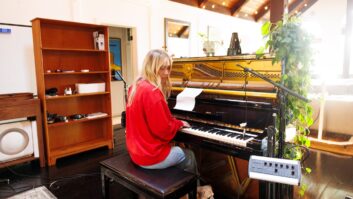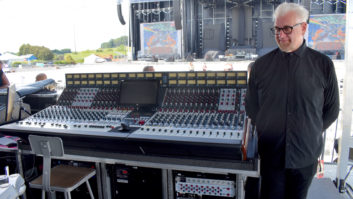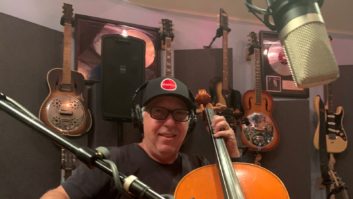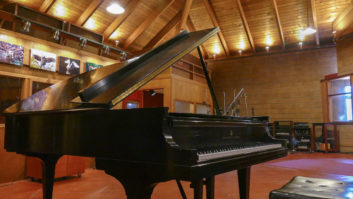Mixing it up with your longtime engineer? Say it ain’t so, Weezer.
Not many artists have the gumption or clout to go up against a respected mixer with a Platinum touch such as Tom Lord-Alge. But then again, not many bands are Weezer. After selling out venues around the world and silencing naysayers who once dismissed them as one-hit wonders, the band decided to stick to their guns for their latest recording. And that meant occasionally tangling with a veteran who has mixed everyone from the Rolling Stones and Billy Joel to Blink-182 and Marilyn Manson.
“We would fight with him. We’d be like, ‘C’mon, dude, there’s good stuff on here,’” says Weezer co-founder and drummer Patrick Wilson. “Scott [Shriner, bassist and vocalist] especially was fighting with him because he was a tone monster. I mean, he plays a vintage P-Bass through an SVT and he takes a lot of pride in his sound, and here comes Lord-Alge who’s like, ‘Okay! We’re not going to use the amp sound. Let’s plug it right into the SansAmp.’ Scott was bombed. He was like, ‘Ggg-uhhhh.’”
That’s the sound of a band trying to define and defend its identity, while striking a balance between the sounds they hear in their heads and those that end up on the radio. And the making of Weezer’s fourth self-produced album, Maladroit, contrary to the awkwardness implied by its title, shows a combo that’s sure enough of themselves to want to do things their own way and resist market pressures. (The band even took over all of their own publicity for the album, sending out copies to radio stations and journalists.)
Call it the nine-year-old group’s coming of age — or a throwback to an earlier, more innocent time — Maladroit boldly hearkens back to the ’80s hard rock and metal that inspired bandleader, vocalist and guitarist Rivers Cuomo to pick up an instrument in the first place. Crisp with the inexorable, mechanistic rhythms and raunchy cymbal crashes of the finest hair bands, the album kicks off with the metallic guitar crunch and trebly solos of “American Gigolo” and continues it with monster power chords and sing-along choruses, along with a harder attack on “Dope Nose” and “Take Control.” Cuomo’s and Brian Bell’s ever-raging guitars are sutured to the ethereal ballad “Death and Destruction”, and to the funky “Time Is Tight”-esque “Burndt Jamb.” Beneath it all: A bedrock of Beach Boy-sweet melodies and doo-wop-tinged harmonies on songs such as “Slave” and “December.”
All of which intrigued independent L.A. engineer Chad Bamford. He spent a month working with the band in Cuomo’s garage during pre-production for the band’s last CD, Weezer (“Green Album”), and found that the group was just his speed. “They’re a very interesting group of guys, and they work in a fairly unconventional way, which I actually love, though I think it would drive a lot of people crazy,” explains the engineer. He had previously worked with Perry Farrell, in addition to Spiritualized’s Jason Pierce on the critically acclaimed Ladies and Gentlemen We Are Floating in Space. “[Maladroit] was definitely not a traditional method of recording,” Bamford says, “meaning it’s not ‘Okay, we’re going to go in for these four days and cut the drums on all the songs, and then we’re going to take two days and do bass on all the songs.’
“It’s really a constantly evolving process. It involves everything. We were literally still cutting drum tracks up to about 12 hours before they had to leave to go mix,” he continues with a laugh. “So, basically, everything’s always on the table and always up and always ready to go, depending on how they feel and what we feel we need to do. I guess they’re just trying to stay flexible.”
When Bamford encountered Weezer this time, around Christmas, the band had just come off tour. Using their own money, they jumped straight into the L.A.-based Capitol Studio B with songs Cuomo had stockpiled.
“Actually, we had sort of an anti-focus of, ‘Let’s not think about anything,’” Wilson says. “‘Let’s just trust people to let us know when we had a good take.’ It’s not the type of music that you need a massive production on. It was more or less, ‘Let’s get the good take, let’s get the inspired take.’”
If anything, the band was striving for a more live, powerful sound. The drummer speaks fondly of some “sloppy” but exciting live recordings that the band made when they came back from a two-year break in 2000 to play the Vans Warped Tour. “Then, we made the ‘Green Album,’ and I think we got away from that a little bit and it was a little stiff and a little cookie-cutter,” he says.
The key was to maintain that live feel. Cuomo, Bell and Shriner, for instance, like to sing together. “They play live so much. Coming into the studio usually is a little tough for them, because they basically don’t take a lot of time off. If they’re not on the road, they’re in the studio,” Bamford says. “So that’s one of the big struggles: Getting them happy in the studio because they’re coming off the road where they have their in-ears with their perfect, precise monitors that never change, and playing right next to their amplifiers and just having all the electricity that you get live. Then they come into the studio and are kind of shackled to headphones and then separated from their amplifiers.”
What started out as pre-production on background parts and arrangements quickly turned into recording sessions, Bamford says, with the band completing at least four songs for the album in about a week. After the 12- to 15-hour days in the studio for their 1994 debut, Weezer (the “Blue Album”), and the long, five-year lag between Weezer’s 1996 sophomore release, Pinkerton, and the “Green Album,” the process went extremely smooth. Then, with the album taking shape, Bamford and the band shifted to Cello’s Studio One in L.A. for three weeks. Every day at noon, Shriner would shuffle in and play bass for a couple of hours on whatever had been cut the night before. Then Bell would come in, record his guitar on the previous night’s tracks, and perhaps work out backup vocals and background arrangements with Shriner. Cuomo and Wilson would show up at 6 p.m., and the entire band would track three or four songs until about 10 p.m. and work on vocals until midnight.
“All three of them were out there with live mics, coming up with their parts all at the same time, which was kind of fun,” says Bamford. “I think it helps them to basically get a little bit of excitement off each other. They’re so tuned in and used to playing live.” Bamford would end the workday by compiling and cataloging the tracks in Pro Tools so that the band could compare notes. “Basically, we did a little bit of everything every day.”
The initial Capitol sessions played a big role in the drum sound, Bamford says. The band wanted to focus on background arrangements, so Wilson was crammed into a small iso booth, “barely big enough to fit a piano,” the engineer says, so that the vocal mics in the main room would be a little cleaner and the rest of the band would be able to hear themselves. “It actually worked into a pretty cool thing that we liked,” Bamford says. “We ended up with a fairly tight, dry drum sound, and even when we got to the point where we realized we were making the record, we kind of stuck with that.
“There weren’t a lot of big distant room mics, just because there wasn’t the room,” he continues. “The iso booth at Capital wasn’t terribly flattering, so I was trying as much as possible to make it sound like it wasn’t being cut in that room. The one at Cello was definitely a lot more friendly, but at that point, we knew we were going for a drier, tighter sound, so there wasn’t a ton of room mics.”
Instead, Bamford used a standard array and a couple of close room mics. He placed a few PZMs about a foot-and-a-half in front of the kick drum and a foot-and-a-half on either side to catch a little of the overall kit sound. “It gives it more of how drums sound to people in a room,” Wilson says. “It’s not that huge, open sound. It’s kind of halfway in between. I’m not sure how much Lord-Alge mixed that in, but I really liked it when I heard it.”
Striving for the big drum sound of Tony Thompson on David Bowie’s Let’s Dance, “because I think that’s one of the last periods in modern music where really produced stuff has a real drummer playing on it.” Wilson attributes the power behind his own boldly bombastic sound to the absence of a click track. “I know it was holding me back, which used to be a good thing because I would rush severely, but it just made everything tame and safe and it’s pretty subtle, but we didn’t like it. We’d listen to those recordings that we made live and we’d be like, ‘There’s some real excitement going on here — let’s try and get that.’ Now the songs definitely breathe, and it’s just more alive-sounding. It doesn’t sound like this perfect thing that people have quantized to death. If you’re going to do that, why not just use FruityLoops? Use QBass and sequence all the drums, because that’s essentially what you’re trying to get anyway. We hate that.”
For the rumbling, omnipresent Maladroit guitar sound, Bamford recorded Cuomo’s Gibson Explorer and Bell’s Gibson SG in the same room as their cabinets, which were sheltered in “little dog houses.” Shriner’s Fender Jazzmaster bass was off in another little iso booth, or the bassist would do his overdubs in the control room with the Yamaha NS-10s cranked up.
For vocals, Bamford used three U87s along with 1176s. “Rivers definitely enjoys compression,” he says. “We’d go back and forth a little bit about how much he actually wanted to be hearing in his head as opposed to how much I was able to print to tape.” Otherwise, the recording of Maladroit didn’t boast “a lot of studio trickery,” Bamford says. “And in the end, it ends up sounding like a very live record, and if you see them live, it’s not significantly different from the record. I think that was also part of what they were shooting for.”
In fact, some parts were even simplified so that they could be performed live. When Bell came up with three different parts he wanted to do on three different tracks of a song, Cuomo would urge him to condense it down to one track. “The vocals were a little bit the same way,” Bamford says. “We didn’t double anything.”
At both studios, Bamford worked on a Neve console, which is what the band prefers. He also used a pair of old ADM Audio Design-manufactured console strips. “Basically, big old, beefy channel strips. That was what I would use for the PZMs, but other than that, it was just the usual Neve console for most of the mic pre’s,” Bamford says, adding that he also relied on the usual compressors, LA-2As, dbx 160s and a B72 for the bass DI.
In the end, Bamford and Weezer recorded about 30 songs that the band then narrowed to 13 or 15. “Literally, a couple days before it went to be mixed, we still weren’t sure which songs were going to be on the record. It was much more about trying to get a number of songs done,” Bamford notes.
The mixing process at Tom Lord-Alge’s Miami studio took a few weeks, sans Wilson. He wasn’t involved in the background vocals that were completed there, but he says Weezer consultant Tom Sullivan spoke for his drum parts. “I think if we didn’t fight for stuff, it would sound like Creed. And I don’t think any of us want that,” Wilson says.
After listening to the mix stories and the resulting recording, Wilson believes the band and Lord-Alge finally found a happy medium with Maladroit. “He does the best radio mixes; that’s all there is to it,” he says. “I mean, a program director sees ‘Tom Lord-Alge’ and they’re like, ‘Done!’ He does a good job at making it sound exciting.”
And Bamford was happy to know that the band was pleased with the results. The proof is the fact that as Bamford spoke in April, he was already back in the studio with Weezer recording an album scheduled for release in February 2003. The band is going to try to mix touring and recording every other month while they’re feeling productive. He describes the new music as “kind of a shift back toward a little more melody, a little less riff-oriented, and more song- and melody-oriented.”
That musical shift is part and parcel of a creatively evolving and technically developing band, able to take its punches — and deliver them, too. “What we want to hear from us is exciting recordings that sound like people who were having a good time, and I don’t hear that in a lot of music today,” Wilson says. “I think it’s because a lot of bands get talked into making these ‘perfect-sounding’ records because shareholders are demanding it from executives. But it creates these fake acts that can’t go out and play, and that’s a drag. I mean, God bless ’em if they can go out and make money doing that. But it’s just not solid. It’s just not a solid scene.”







